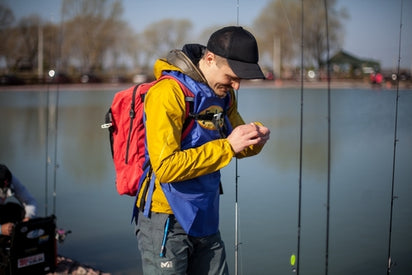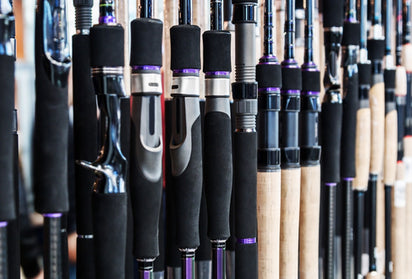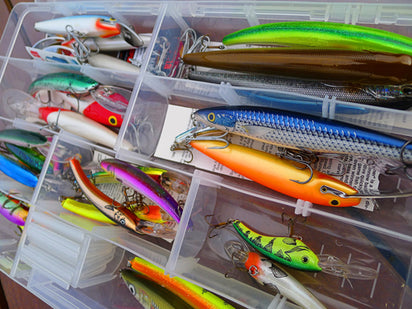Types of Fishing Rods: The Complete Guide
Types of Fishing Rods and Fishing Rod Buying Guide
Having the best possible rod equipment is as crucial in fishing as it is in any sport. The primary things to consider while picking a rod are the place you’ll be fishing (lakes, waterways, streams and so forth.), the sort of fish you’re after, and the kind of bait you’ll be using. The distinction in rods come down to length, weight (a measure of the rod ‘s quality), and activity (how far it will twist before its prepared to spring back).
Basics in Fishing Rod
There are things you’re considering on how to pick a fishing rod. It’s best to know the diverse parts and qualities that make up this fishing gear.
• It starts from the base or butt-end of the bar climbing. The main thing you will experience is the handle or grasp, generally produced using plug or froth. This is the end of the rod, where you will hold it when casting and recovering.
• Each angling rod bar is a balance of adaptability and quality. Stronger rod can cast heavier draws. However, it won’t be as sensitive to strike from a fish, or may not flex enough to function with lightweight line. Lighter rod might be delicate, yet not robust enough to fight greater fish.
• Rods arrive in different lengths. Shorter rods give more power to fighting a fish. They are used for trolling and big game fishing. Longer rods can cast more distance — surf casting rod and fly rods are very long up to 14 feet. These rods disassemble into up to four pieces for less demanding transport. Most rods up to around 6 feet are one-piece.
Kinds of Rods According to Material
Fishing rods can be created from different materials. For example, bamboo, graphite, fiberglass or composite. These influence the bar’s activity and to your ability level and angling mode. There are three fundamental types.
• Fiberglass rods
Made for beginners. These rods need little support with average weight and strong rod power. You may be fishing for bigger fish, for example, muskie, walleye or pike. Y you need an heavy, strong rod for recovering the battling fish, fiberglass rods work best.
• Graphite Rods
Usually favored by advanced fishermen because of their high quality and lightness. The lightweight graphite handles most angling circumstances well. This gives more battling power in the bar.
• Bamboo Rods
It produces a smooth, fluid backcast. This gives its own particular dampening impact toward the end of the back cast. It includes the most elevated quality worked from Tonkin stick.
Types of Fishing Rods
Casting Rods
Casting rod, otherwise called spin cast rods. They hold a casting reel mounted over the handle. Casting rods are the least demanding kind of bar to use. It has a straightforward push-catch line discharge for casting and an encased “nosecone” where the line leaves the reel. They are also the cheapest kind of fishing rod. So this is a great decision for first-time fishers. Casting rod are reasonable for most sorts of lake and waterway angling. They are more effective than spinning rod. This is because they can use heavier line and handle heavier cover (weeds, rocks and so forth).
Spinning Rods
Not like the casting rod, with a spinning rod the reel hangs underneath the rod opposite to the top. They also need more system, as your second and third fingers must straddle the leg of the reel where it joins to the bar. The main advantage is that it enables you to hold the rod in your dominant hand which builds control.
Also, having the weight of the reel hang beneath the rod opens for a more comfortable fishing over longer time. Spinning rod are superior to casting rod. Casting light draws or trap the line. It can peel off unrestricted by either a nosecone or the contact of a casting rod’s reel spool. They are generally utilized for sport angle including bass, trout, pike and walleye.
Ultra-Light Rods
Initially, it conveys more challenge and thrill to finding a fish. The ultra-light rod are shorter in length, lighter built and lighter lines. They are used to angle for smaller fishes like trout, bass and different sorts of pan fish. A panfish is a fish that fit in a normal measured skillet. Yet few fishermen expand their usage to bigger fishes too. The lighter fishing line and little measured lure are less inclined to frighten off smaller fish, so they have a tendency to get more little fish by and large than different rod. Typical bait choices for a ultra-light rod are little spinners, wet flies, tubes or plastic worms.
Fly Rods
A fly rod is a particularly intended for fly fishing. It includes casting a lightweight draw, known as a “fake fly,” appended to a weighted line. The bait is masked with brilliantly shaded plumes, hide, hair and different materials to pull in the fish, while the overwhelming line sinks out of site. Fly rod can be utilized to get numerous sorts of fish, including trout, salmon, carp, pike, bass, and even marlin and sharks. The size of the bar relies upon the size of fish you’re endeavoring to get — the bigger the fish, the heavier the bar required.
Telescopic Fishing Rod
Telescopic angling rods are developed to either crumple down to a short length or open up into a more extended bar. This is an advantage in case you’re going by foot, bicycle, minimal auto or public transit. Telescopic fishing rods are particularly helpful in surf angling, which requires especially long rod of up to 14′ long. When you pick a telescopic rod, take care to keep the joints spotless as earth or sand could cause harm that debilitates the rod’s adaptive activity.
Surf Rods
Surf rods are commonly utilized as a part of fishing in the sea from the shoreline, rocks or other sort of shoreline. They look like larger than usual spinning rod however have long hold handles for two-gave casting. Surf rods are long (3 – 4 m) so you can cast past the breaking surf where angle have a tendency to gather. They are additionally sufficiently strong to cast the substantial draws or lure expected to hold the base in unpleasant water.
Trolling Rods
Trolling entails casting from a moving boat and letting the motion of the boat pull the bait through the water. They are mostly used for ocean and Great Lakes fishing. A good spinning rod will usually work fine for most inland lake and stream fishing. Trolling rods are stiff with relatively fast action, as a slow action rod is too whippy for trolling off a faster moving boat.
How to Select the Right Fishing Rod
Rod Length
The typical length of a fishing rod goes from 6 to 12 feet. Length of your rod depends on the kind of fishing you intend to do, the species you’re after and your angling condition. Also, consider your own calculating knowledge and quality level. A beginner should start with a short bar to help with control. The development of technique is long enough to give a decent casting distance (8 to 9 feet long).
Children require a shorter bar due to their stature. In wood areas or those with encompassing brush, pick a shorter rod. The wide, open spaces, where you would be destined to fly fish, pick a more extended rod. To get bigger, stronger fish, you will also need a stronger, shorter rod. More or less, the more drawn out the rod, the more control a fisher has over a fish.
Power
Power is the amount of pressure a fisherman needs to apply to make a rod to bend. Heavier action rod need more strain to twist, while light action rod bend less. Power comes down to the strong forces that the rod can remain to deal with. Numerous factors come into this condition, for example, materials, and size of the bar. The present posts compose of wide range of materials in a consistent fight for the best feel and thus best part. A portion of the best fishing rods available are interpreted through a blend of both graphite, and fiberglass.
Action
Before proceeding, there is one more term you need to know when attempting to choose the correct rod. That term is Action. The Aciton of a rod is the flexibility of the bar. And, the action of a rod portrays how much and where a bar ends when its “stacked” (bent). There are three principle actions:
Fast Action
This sort of rod is for the most part solid, and the majority of the curve occurs at the tip some portion of the rod.
Medium/Moderate Action
This bar bends somewhat deeper, so it has flexibility in the tip and amidst the rod.
Slow Action
This rod is the most flexible, it bends well into the butt end of the rod. The sort of activity you need to rely upon what you intend to do with it. Also what sort of fish you are focusing on and what sort of strategy you intend to use.
Power and Action
Action decides how much control you have over the fish. The faster the action, the more weight you can put on the fish. Power is your rod weight. So choosing the kind of fish you need to catch will decide the power you need for your rod.
Power
Rods in different kinds. They are ultra-light, light, medium-light, medium, medium-heavy, heavy, ultra-heavy, or other like combinations. Ultra-light rods are reasonable for getting little bait fish and also pan fish. Or just any circumstances where rod responsiveness is crucial. Ultra-Heavy rods are utilized as a part of deep sea fishing, surf angling, or for heavy fish by weight.
Action
It affects casting accuracy and distance. Likewise, it is identifies with the draw or baits you need. You also need the strength of the reel that you are going to use. The smaller the fish, the lighter the action required. However, the heavier the fish, the heavier the action is. An action might be slow, medium, fast or a combination (e.g. medium-quick.) Additional fast action rod bends exactly at the tip. A fast action bends in the last quarter of the rod. Moderate-fast action bar bends around the last third. Direct action rod bends around the last half. Moderate action rod bends all the way into the handle.
Line, Lure, Length & Weight
A rod’s weight and length must be matched to the weight of your line. A rod may likewise be depicted by the weight of lure or hook that the bar is intended to support. Lure weight is generally measured in ounces or grams. Choosing the ideal bass fishing rod begins with bait choice. Using a flipping rod to fish with crank baits would be just as difficult. You could cast a crankbait with a flipping rod. The distance, accuracy, and capacity to land bass may endure.
Knowing the distinctive parts of a bar – and how they influence casting and fighting a bass – is the initial step in choosing the best possible rod for the current task. Otherwise called the rod’s “energy”, angling rods are ultra-light, light, medium-light, medium, medium-substantial, overwhelming and ultra-Heavy.
The weight is a decent pointer of the size, species or sort of looking for which a rod is most appropriate. Ultra-light rods are appropriate for getting panfish, baitfish and other little fish that require a moderate activity reaction. They are part of surf angling, or for to a great degree overwhelming fish. The way to maintain a strategic distance from broken rods or lost fish is to use the rod in the correct circumstances.
Action Ranges and Target Fishes:
• Ultra-Heavy: Sailfish, Shark, Tuna, Halibut
• Heavy: Tuna, Sturgeon, Salmon, Tarpon
• Light: skillet angle, bluegill, sunfish, Jacks, Drums
• Medium:Bass, Catfish, Redfish
• Medium Light: Bass, Walleye, Trout
• Medium-Heavy: Pike, Musky, Snook, Salmon
• Ultra-Light: Crappie, baits, most little fish
Fishing Rod Buying Tips
• Choose a medium-sized rod for inshore fishing. For the most part, it implies angling in shallow water for angle under 20 pounds
• When angling the bottom of a body of water, it’s best to use a shorter rod
• Fiberglass rods are heavier than carbon fiber rods. But, they are more affordable
• A casting rod is a decent beginner rod since it’s anything but easy to use. It is also more affordable than other kinds of rods.
Conclusion
Having the best possible equipment is as critical in fishing as it is in any game. With wide variety of lure choices and techniques, rod makers have created rod to cast particular baits deeper and more accurately. They’ve also adjusted these abilities with different factors to give the fisherman advantages over a hooked bass. The right bar for a given situation enables fishermen to cast draws precisely, work baits appropriately, distinguish more strikes, and set the baits to land a fish. A successful fisher would now be able to pick the ideal equipment.










